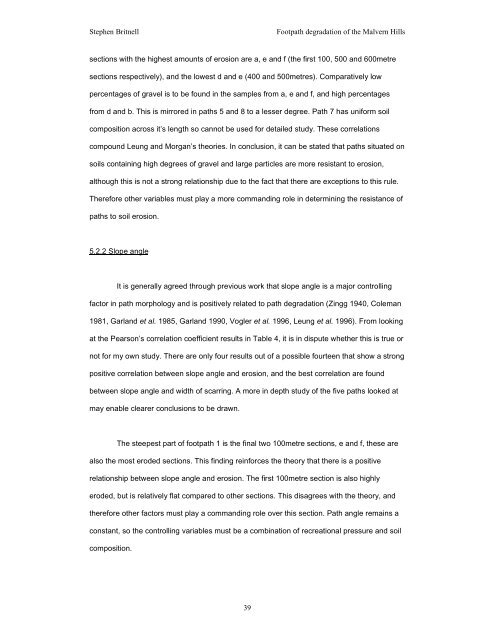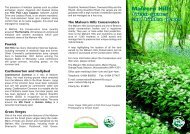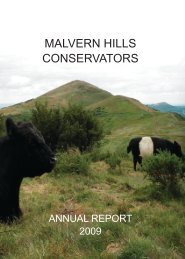Footpath degradation of the Malvern Hills - Malvern Hills Conservators
Footpath degradation of the Malvern Hills - Malvern Hills Conservators
Footpath degradation of the Malvern Hills - Malvern Hills Conservators
Create successful ePaper yourself
Turn your PDF publications into a flip-book with our unique Google optimized e-Paper software.
Stephen Britnell<br />
<strong>Footpath</strong> <strong>degradation</strong> <strong>of</strong> <strong>the</strong> <strong>Malvern</strong> <strong>Hills</strong><br />
sections with <strong>the</strong> highest amounts <strong>of</strong> erosion are a, e and f (<strong>the</strong> first 100, 500 and 600metre<br />
sections respectively), and <strong>the</strong> lowest d and e (400 and 500metres). Comparatively low<br />
percentages <strong>of</strong> gravel is to be found in <strong>the</strong> samples from a, e and f, and high percentages<br />
from d and b. This is mirrored in paths 5 and 8 to a lesser degree. Path 7 has uniform soil<br />
composition across it’s length so cannot be used for detailed study. These correlations<br />
compound Leung and Morgan’s <strong>the</strong>ories. In conclusion, it can be stated that paths situated on<br />
soils containing high degrees <strong>of</strong> gravel and large particles are more resistant to erosion,<br />
although this is not a strong relationship due to <strong>the</strong> fact that <strong>the</strong>re are exceptions to this rule.<br />
Therefore o<strong>the</strong>r variables must play a more commanding role in determining <strong>the</strong> resistance <strong>of</strong><br />
paths to soil erosion.<br />
5.2.2 Slope angle<br />
It is generally agreed through previous work that slope angle is a major controlling<br />
factor in path morphology and is positively related to path <strong>degradation</strong> (Zingg 1940, Coleman<br />
1981, Garland et al. 1985, Garland 1990, Vogler et al. 1996, Leung et al. 1996). From looking<br />
at <strong>the</strong> Pearson’s correlation coefficient results in Table 4, it is in dispute whe<strong>the</strong>r this is true or<br />
not for my own study. There are only four results out <strong>of</strong> a possible fourteen that show a strong<br />
positive correlation between slope angle and erosion, and <strong>the</strong> best correlation are found<br />
between slope angle and width <strong>of</strong> scarring. A more in depth study <strong>of</strong> <strong>the</strong> five paths looked at<br />
may enable clearer conclusions to be drawn.<br />
The steepest part <strong>of</strong> footpath 1 is <strong>the</strong> final two 100metre sections, e and f, <strong>the</strong>se are<br />
also <strong>the</strong> most eroded sections. This finding reinforces <strong>the</strong> <strong>the</strong>ory that <strong>the</strong>re is a positive<br />
relationship between slope angle and erosion. The first 100metre section is also highly<br />
eroded, but is relatively flat compared to o<strong>the</strong>r sections. This disagrees with <strong>the</strong> <strong>the</strong>ory, and<br />
<strong>the</strong>refore o<strong>the</strong>r factors must play a commanding role over this section. Path angle remains a<br />
constant, so <strong>the</strong> controlling variables must be a combination <strong>of</strong> recreational pressure and soil<br />
composition.<br />
39





